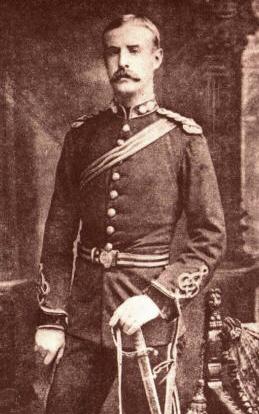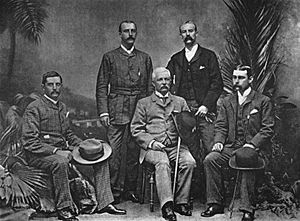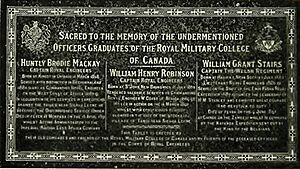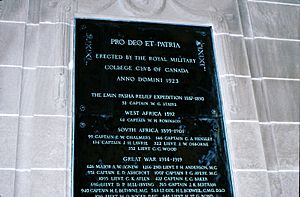William Grant Stairs facts for kids
Quick facts for kids
William Grant Stairs
|
|
|---|---|
 |
|
| Born | 1 July 1863 Halifax, Nova Scotia |
| Died | 9 June 1892 (aged 28) Mozambique |
| Allegiance | Canadian-British |
| Rank | Captain |
| Commands held | Stairs Expedition to Katanga Emin Pasha Relief Expedition |
| Relations | William Machin Stairs (grandfather) |
| Other work | explorer |
William Grant Stairs (born July 1, 1863 – died June 9, 1892) was a Canadian-British explorer, soldier, and adventurer. He played a key role in two important expeditions during the "Scramble for Africa." This was a time when European countries were trying to claim parts of Africa.
Contents
Early Life and Education
William Grant Stairs was born in Halifax, Nova Scotia. He was the sixth child in his family. He went to school in Halifax, then in Edinburgh, Scotland. Later, he studied at the Royal Military College of Canada in Kingston, Ontario.
Starting His Career
After finishing his studies as an engineer, Stairs worked for three years in New Zealand. He helped with land surveys there. In 1885, he joined the British Royal Engineers as an officer. He trained in England before transferring to the Welsh Regiment in 1891.
Exploring Africa: The Emin Pasha Expedition
Captain Stairs joined the Emin Pasha Relief Expedition. This journey was led by Henry Morton Stanley, a very famous explorer of Africa. Stairs started his trip from London in January 1887. He met Stanley in Suez and their expedition began in March.
The team traveled about 5,000 kilometers (3,100 miles) across Africa. They went through very tough areas, including thick rainforests and swamps. Stairs and his fellow explorers often got sick with diseases like malaria.
Despite the challenges, Stairs showed great strength and determination. He found one of the sources of the Nile River, called the Semliki River. He also became the first non-African to climb in the Rwenzori Mountains. He reached a height of 10,677 feet before turning back.

During the journey, Stairs was badly hurt by a poisonous arrow during a conflict with local people. Many locals thought the expedition was a slave-raiding group. Stairs recovered from his injury and continued the journey. In Dublin, Ireland, there is a plaque honoring the doctor, Thomas Heazle Parke, who removed the arrow and helped Stairs.
When the expedition returned, it was praised in Europe and North America. Stairs was recognized for his bravery. However, some details about the expedition's actions also came out. There were criticisms about how the expedition treated local Africans and even their own porters.
The Stairs Expedition to Katanga
In 1891, King Leopold II of Belgium asked Stairs to lead another mission. This time, the goal was to take control of a region called Katanga, also known as Garanganze. This area was ruled by a powerful king named Msiri.
The Stairs Expedition was a military mission with 400 men. They carried modern rifles, while Msiri's men had older guns. Stairs led a well-organized team. His expedition was smaller than his previous one, with only two other military officers. They were in a race against another British group trying to claim Katanga.
The Stairs Expedition became known for what happened to King Msiri. After three days of talks, Stairs told Msiri to sign a treaty. When Msiri did not appear, Stairs sent his second-in-command, Omer Bodson, to arrest him. During this event, Msiri was killed. The expedition then took control of the area.
Stairs appointed Msiri's adopted son, Makanda Bantu, as the new chief. Makanda Bantu signed the treaty, agreeing that Leopold would be the ruler of Katanga.
Stairs became ill with malaria in January 1892. After another expedition took over, Stairs began the long trip back to Zanzibar. He was often sick. In May 1892, he seemed to recover. But on a boat trip down the Zambezi River, he had another severe attack of malaria. He died on June 9, 1892. He is buried in Mozambique.
Only 189 of the 400 men on the expedition returned to Zanzibar. Most of the others died or left the group. Katanga became part of the Congo Free State. Later, in 1908, Belgium took control of the Congo Free State due to international concerns about the actions of Leopold's rule.
Remembering William Grant Stairs

Captain Stairs is remembered with three special plaques. These plaques are found at the Royal Military College of Canada, St. George's Cathedral (Kingston, Ontario), and Rochester Cathedral in England.
One plaque says: "William Grant Stairs, Captain the Welsh Regiment. Born at Halifax Nova Scotia 1 July 1863. Lieutenant Royal Engineers 1885–91. Served on the staff of the Emin Pasha Relief Expedition 1887 under the leadership of H.M. Stanley and exhibited great courage and devotion to duty. Died of fever on 9 June 1892 at Chinde on the Zambesi whilst in command of the Katanga Expedition sent out by the King of the Belgians."
Another plaque at the Royal Military College of Canada Memorial Arch, put up in 1932, also mentions him.
Some items from his African expeditions are kept at Fort Frederick in Kingston. Some of his personal diaries are stored in the Public Archives of Nova Scotia.
Several places are named after him. These include Stairs Island in Ontario, and Stairs Street and Stairs Place in Halifax, Nova Scotia.


